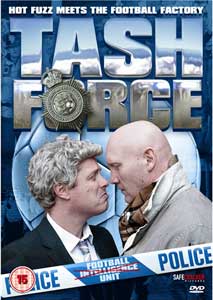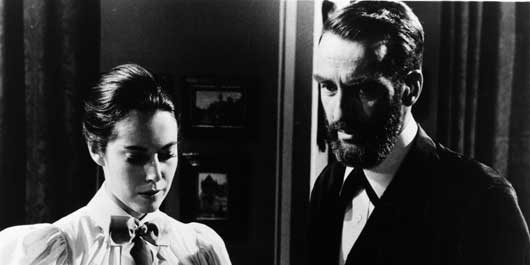 The Five Year Engagement is bidding to be this year’s big gross-out rom com hit and from the evidence of this red band trailer, it’s gonna be a lot of fun. You normally think of women trying to strong-arm men into marriage, but The Five-Tear Engagement sees things from the other side, with Jason Segel being forced to delay marrying Emily Blunt so she can get on with her career. Here’s the synopsis: ‘The director and writer/star of Forgetting Sarah Marshall reteam for the irreverent comedy The Five-Year Engagement. Beginning where most romantic comedies end, the new film from director Nicholas Stoller, producer Judd Apatow and Rodney Rothman looks at what happens when an engaged couple, Jason Segel and Emily Blunt, keeps getting tripped up on the long walk down the aisle.’ It’s due in UK cinemas June 22nd.
The Five Year Engagement is bidding to be this year’s big gross-out rom com hit and from the evidence of this red band trailer, it’s gonna be a lot of fun. You normally think of women trying to strong-arm men into marriage, but The Five-Tear Engagement sees things from the other side, with Jason Segel being forced to delay marrying Emily Blunt so she can get on with her career. Here’s the synopsis: ‘The director and writer/star of Forgetting Sarah Marshall reteam for the irreverent comedy The Five-Year Engagement. Beginning where most romantic comedies end, the new film from director Nicholas Stoller, producer Judd Apatow and Rodney Rothman looks at what happens when an engaged couple, Jason Segel and Emily Blunt, keeps getting tripped up on the long walk down the aisle.’ It’s due in UK cinemas June 22nd.
The Impossible Trailer – Ewan McGregor & Naomi Watts star in The Orphanage director’s tsunami drama
 The Boxing Day tsunami was such a huge event that film has often seemed unsure how to deal with it. There was an exceptional sequence in Hereafter, but the first major movie to deal head-on with it will come this year with The Impossible, from The Orphanage director Juan Antonio Bayona. The first full trailer has now appeared, and while it’s dubbed in Spanish, it introduces us to Ewan McGregor and Naomi Watts as a mother and father who are on holiday in Thailand with their kids when the tsunami hits. Separated from one another, they must find each other amongst the debris. It doesn’t seem it’ll be an easy watch, but it should hit cinemas this autumn.
The Boxing Day tsunami was such a huge event that film has often seemed unsure how to deal with it. There was an exceptional sequence in Hereafter, but the first major movie to deal head-on with it will come this year with The Impossible, from The Orphanage director Juan Antonio Bayona. The first full trailer has now appeared, and while it’s dubbed in Spanish, it introduces us to Ewan McGregor and Naomi Watts as a mother and father who are on holiday in Thailand with their kids when the tsunami hits. Separated from one another, they must find each other amongst the debris. It doesn’t seem it’ll be an easy watch, but it should hit cinemas this autumn.
The Lady (Blu-ray) – Michelle Yeoh takes on Aung San Suu Kyi

Unless you’re a member of Burma’s former military junta, pretty much everyone can agree that Aung San Suu Kyi is a great person who’s had to endure a lot. However she’s also a human being, something The Lady seems to forget. Instead here she’s a saint taking on demons, which results in a film that’s informative but earnest and rather dull.
Aung San Suu Kyi (Michelle Yeoh) is the daughter of the man who negotiated Britain’s independence from Britain but who was assassinated the same year by his political rivals. However, when the film opens she is living as an Oxford housewife with her academic husband, Michael (David Thewlis), and her two children. She then returns to Burma to look after her ailing mother but once there sees the brutality of the military dictatorship, which is suppressing any and all dissent with deadly force.
Those in the country who believe in democracy know that Aung San Suu Kyi’s position as the daughter of a beloved martyr makes her a strong rallying point for their cause, and so she agrees to lead the pro-democracy movement. This puts her in the sights of the military junta, who realise that killing her will only make her a martyr. However as the popularity of her movement grows, they try various ways to silence her, from a rigged election to house arrest. They also begin to use her family against her, hoping that keeping her husband and children away from her in England will either stop her calls for democracy or entice her to leave Burma (knowing she won’t be allowed back if she ever does go).
The film then charts her years of house arrest, which become particularly difficult in 1997 when her husband is diagnosed with prostate cancer. As his illness becomes more serious, the Burmese government refuses to allow him into the country to see his wife, or allow her out with a guarantee she can return. She knows her house arrest sends a powerful statement about her cause, but with her husband dying, the sacrifice seems too great.
The Lady hits DVD and Blu-ray just as reform in Burma mean the now freed Aung San Suu Kyi and many of her pro-democracy colleagues are set to take up seats in the country’s parliament (assuming some issues surrounding the oath they’d have to take is sorted out). Burma certainly isn’t a free country yet, but it’s made strides since this film first went into production (when it started shooting Aung San Suu Kyi was still under house arrest).
The film’s problem is that in the west, most of those who’ve heard of Aung San Suu Kyi know little about what she actually did and see her more as a symbol of peaceful resistance. The Lady never gets past her as that representation of passive defiance, painting her as this almost perfect being who floats magnanimously above all others.
The problem is that there’s more moral complexity to her decisions than the film wants to admit – she decided to put her country ahead of her children, and she decided to push for democracy knowing the potential danger it caused for those around her. They were brave but morally complex decisions, but the film prefers her as perennially put-upon demi-god than admitting the complexity of a real human being. Likewise the Burmese dictatorship was/is a horrible and astonishingly brutal thing, but here it comes across more as a movie monster than anything else.
There is undoubtedly a fascinating movie to be made about Aung San Suu Kyi, but it needs to be less absolute devotion to its subject and have a stronger grasp of the politics it’s dealing with. The awe all those involved felt for the film’s subject is apparent in the making of’ featurette, with Luc Besson in particular coming across as blind to the complexities of Aung San Suu Kyi.
The other special feature is Burma: The Dictatorship Of The Absurd’, in which two French documentarians go undercover as tourists in Burma to bring back a rare look at a country that doesn’t welcome outside journalists. Some of it’s quite interesting, although it would have nice if it at least pretended it wasn’t all about the journalists’ agenda to paint the Burmese government in as bad a light as possible. I don’t doubt it’s bad, but this sort of polemic doesn’t come across as trustworthy.
Overall Verdict: The film looks and sounds good on Blu-ray, it’s just a shame The Lady tips so far into hagiography that even while it perfectly clear this is a fascinating story, the movie makes it less interesting than it might have been, largely by making Aung San Suu Kyi seem too much saint and not enough human.
Special Features:
Making Of’ Featurette
Burma: The Dictatorship Of The Absurd’ Featurette
Reviewer: Tim Isaac
WIN! Tash Force DVDs – Get your hands of the new British cop comedy
 The new British comedy Tash Force is out on DVD now, and we’ve got five copies to give away in this great comp! The film is a madcap comedy following Tash McDermott, the head of Lancashire Constabulary’s Football Intelligence Unit, as he tries to track down a football hooligan ring leader, and put a stop to “shenanigans” on the football terraces.
The new British comedy Tash Force is out on DVD now, and we’ve got five copies to give away in this great comp! The film is a madcap comedy following Tash McDermott, the head of Lancashire Constabulary’s Football Intelligence Unit, as he tries to track down a football hooligan ring leader, and put a stop to “shenanigans” on the football terraces.
Tash is on the trail of the elusive ‘Nightmare’, a notorious football firm hooligan. But, inspired by TV programmes like ‘Police, Camera, Action’, Tash gives a journalist unrestricted access to his day to day operations. The trouble is, Tash is still stuck in the glory days of the past, when football was a man’s game, women knew their place, a ruck was pretty much guaranteed, and he was top of the league for arrests and banning orders.
The film is out on DVD on April 23rd through Safecracker Pictures, but if you’d like to try and win one of the five copies we’ve got to give away, sign in to the site below (or click here to register) and answer the multiple choice question (see below for more details on how to enter). The competition closes on May 6th, 2012, so get answering and good luck!
WIN! Freud & The Execution Of Private Slovik DVDs – Two little seen classics could be yours
 Youd think by now that every great classic film would be available on DVD by now but on Monday 23rd April two unreleased films to UK DVD finally come out: Freud directed by the legendary John Huston is a magnificent film noir starring Montgomery Clift, whilst The Execution of Private Slovik an 8 Emmy Award nominated war classic stars the always brilliant Martin Sheen. And weve got a three copies of each of the films to give away to three lucky people.
Youd think by now that every great classic film would be available on DVD by now but on Monday 23rd April two unreleased films to UK DVD finally come out: Freud directed by the legendary John Huston is a magnificent film noir starring Montgomery Clift, whilst The Execution of Private Slovik an 8 Emmy Award nominated war classic stars the always brilliant Martin Sheen. And weve got a three copies of each of the films to give away to three lucky people.
It always amazes me how few Montgomery Clift films people have seen, as he was a superb actor. Freud was his final leading role, as his declining health made film appearances increasingly difficult after 1962, and sees him as the famed psychotherapist, facing scorn for his controversial theories. The Execution of Private Slovik meanwhile is about the man who in 1944 became the only man executed by the US military for desertion since the Civil War.
If you’d like to try and win one of three sets of Freud and The Execution Of Pirvate Slovik that we’ve got to give away, sign in to the site below (or click here to register) and answer the multiple choice question (see below for more details on how to enter). The competition closes on May 6th, 2012, so get answering and good luck!
Freud (DVD) – Montgomery Clift & John Huston go inside the mind

It’s very peculiar that despite Montgomery Clift and Susannah York starring in the film and the legendary John Huston behind the camera, Freud has never been legally available on either VHS or DVD in the UK. That’s now being addressed with this release, which gives a fresh outing for the unusual biopic.
Rather than covering the whole of Sigmund Freud’s life, the film concentrates on the years from 1885 to 1890 when he was developing his most famous theories. Against the backdrop of a medical establishment who believed mental problems either had a physiological cause or were just people pretending, Freud began to explore the idea of the unconscious and his talking cure’, which sought to uncover memories the patient had suppressed and by unlocking them, cure the problems they faced (or at least that’s the overly simplified way it works in the film).
Freud faces the scorn of his colleagues who react badly to much of what he was to say, particularly when he starts to explore ideas of childhood sexuality and the Oedipus effect. The second half of the film concentrates on Freud’s relationship with one particular patient (Susannah York), who has hysterical paralysis. The doctor slowly begins to uncover the traumas and difficulties of her youth, hoping it will allow her to walk again.
There’s no doubt that the film oversimplifies psychological thinking and seems hopelessly outdated on that score in the present day. There are also plenty of modern day mental health professionals who aren’t big fans of Freud and who will take issue with the film’s glowing portrait of him (there’s no doubt Sigmund was as much a master of self-promotion and creating his own narrative, which the film buys into completely, as a master of the human mind). However it’s a fascinating attempt to mix a traditional biopic with more experimental elements, such as rather surreal dreams sequences.
As director John Huston’s voiceover suggests, it’s a film that’s less interested in Freud himself than the possibilities of unlocking the human mind and how that can be shown on screen how can you portray the ideas of psychology on screen? As a result it plays fast and loose with history in favour of trying to uncover what Freud’s ideas mean. It is an interesting and entertaining movie, with a great central performance from Montgomery Clift. While Hollywood legend say John Huston tortures Clift on the set of the movie, asking more from him than was reasonable to expect, there little evidence for that.
However the alcoholic Clift was badly ailing when he made the movie, and his ill health caused so many delays and overruns that Universal eventually tried to sue him over it. After Freud in 1962, he didn’t make another movie until 1966’s The Defector, which he filmed just a few months before he died at the age of only 45. Considering his problems it’s almost ironic to have him playing Freud, with acting teacher Robert Lewis describing his death as longest suicide in history’. Clift’s alcoholism, depression and self-destructive behaviour was largely due to his inability to come to terms with his sexuality (something that wasn’t uncommon at the time, especially as homosexuality was illegal), and while he spent a lot of time on the psychologist’s couch, it didn’t help.
The movie is also, incidentally, thought to be the first Hollywood production that touches explicitly on incest, which comes up when Susannah York’s character is slowly uncovering the reasons for her hysteria.
However while the movie is good, the DVD is less so, as it’s not in anamorphic widescreen. Instead it’s a letterboxed picture, meaning you have zoom in (and therefore lose picture quality) to fill a widescreen TV. While it saves money using a non-anamorphic master, it’s slightly unforgivable in the modern age.
Overall Verdict: A fascinating movie and Clift is always worth watching, but using a non-anamorphic print in 2012 is a big no-no.
Special Features:
None
Reviewer: Tim Isaac
You must be logged in to post a comment.